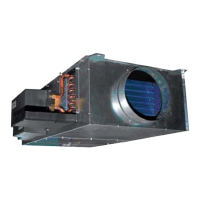Page 19
4 - Compare the normal operating pressures to
the pressures obtained from the gauges. Minor
variations in these pressures may be expected due
to differences in installations. Signicant differences
could mean that the system is not properly charged
or that a problem exists with some component in
the system. Correct any system problems before
proceeding.
5 - If discharge pressure is high, remove refrigerant
from the system. If discharge pressure is low, add
refrigerant to the system.
• Add or remove charge in increments.
• Allow the system to stabilize each time refrigerant is
added or removed.
CHARGE VERIFICATION - APPROACH METHOD
Use the following approach method along with the normal
operating pressures to conrm readings.
1 - Using the same thermometer, compare liquid
temperature at service valve to outdoor ambient
temperature.
Approach Temperature = Liquid temperature minus
ambient temperature
2 - Approach temperature should as indicated in table
4 for each stage. An approach temperature greater
than this value indicates an undercharge. An
approach temperature less than this value indicates
an overcharge.
3 - Do not use the approach method if system pressures
do not match pressures in table 5 except when the
outdoor ambient temperature is below 65ºF (18ºC).
The approach method is not valid for grossly over-
or undercharged systems.
TABLE 4
HFC-410A Approach Temperatures
Models Stage
Approach
Temperature
(ºF)
Approach
Temperature
(ºC)
ELS072S4S 1 4.0 2.2
ELS090S4S 1 7.0 3.9
ELS120S4S 1 4.0 2.2
ELS120S4D
1 5.0 2.8
2 5.0 2.8
ELS150S4D
1 7.0 3.9
2 5.0 2.8
ELS180S4D
1 4.0 2.2
2 4.0 2.2
ELS240S4D
1 7.0 3.9
2 8.0 4.4
TABLE 5
HFC-410A Normal Operating Pressures (Liquid ±10 and Suction ±5 psig) (Single-Stage Units)**
Temp*
-072S4S -090S4S -120S4S
Liquid Suction Liquid Suction Liquid Suction
65 F (18 C)
245 137 240 128 243 135
75 F (24 C)
283 141 294 130 285 136
85 F (29 C)
327 143 338 131 332 138
95 F (35 C)
377 145 385 133 378 139
105 F (41 C)
426 148 435 135 434 141
115 F (46 C)
484 150 489 136 491 142
125 F (52 C)
540 155 545 140 548 146
STD. CFM
2600 2725 3850
*Temperature of air entering outdoor coil.
**With indoor conditions at 80ºF dry bulb and 67ºF wet bulb temperatures.
